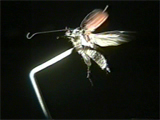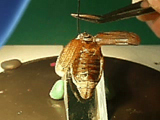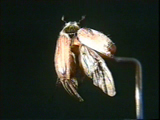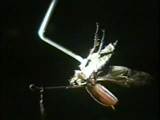Actuation of the closing of the elytra was previously ascribed to
intrinsic muscles in the mesothorax. We investigated closing (1) by loading or arrest
of some thoracic segments in a tethered flying beetle, (2) by animation, i.e. passive
motion of preparations of the thorax simulating the action of some muscle, and (3)
by excision of some parts of sclerites or cuts across certain muscles. We found out
that depression of the prothorax, necessary to unlock the elytra, precedes their opening
but elevation of the prothorax is synchronous with the closing. The closing is retarded
if the elevation is retarded by loading; if the elevating prothorax is clamped, then
the closing is also arrested or hindered; animation of the elevation of the prothorax
in the dead animal is enough for the closing of the previously spread elytra; the
closing is prevented if a piece at the hind edge of the pronotum, positioned in front
of the root of an elytron, is excised. This excision also prevents closing in the
in vivo experiments. Mechanical interaction between the elytron and the prothorax
is limited to the contact point between the posterior edge of the pronotum and the
lateral apophysis of the root. Thus, the elevation of the prothorax is the indirect
and main mechanism of the closing in Melolontha.
 |
 |
| Arrest of the prothorax with elytra amidst the flight. |
Approach of the pronotum toward the mesotergite during the closing. |
 |
 |
| Coordination between body parts during the normal flight. |
Animation of the closing of the elytra by elevation of the prothorax in a
dead beetle. |
 |
 |
| Animation of the closing by pricking toward the root of the elytron in a preparation
of the pterothorax. |
Animation of the closing fails after the excision of the left counterroot
piece of the pronotum in a dead beetle. |
 |
 |
| Inability to close the right elytron after the excision of the right counterroot
piece of the pronotum in vivo. |
Closing in a loaded beetle tethered upright. |
 |
Closing in a loaded beetle
tethered upside down. |



